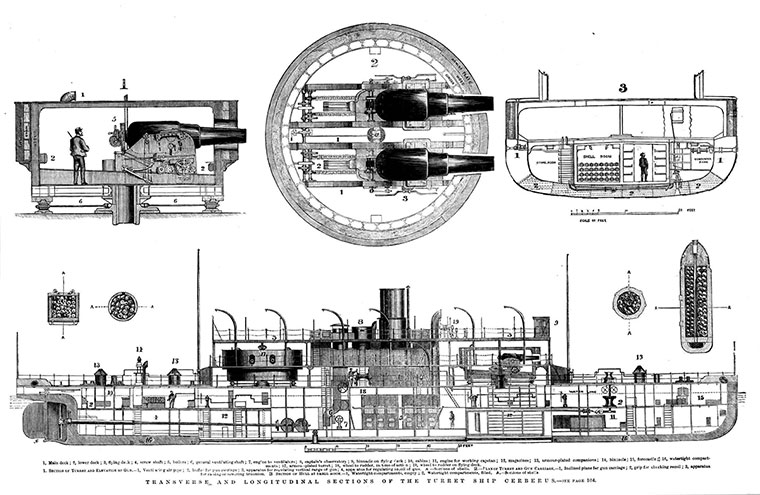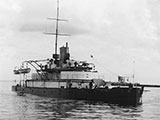Cerberus
![]() Wreck Dive |
Wreck Dive | ![]() Shore access
Shore access
![]()
![]()
Iron Breastwork Monitor | Max Depth: 7 m (23 ft)
Historic shipwreck protected zone. Permit Required.
For more details please see vic-shipwreck-protection-zones.
Do not dive or snorkel near the Cerberus. The shipwreck lies in a 0.5-hectare protection zone. If you enter this zone severe penalties apply. Stay clear!
The Cerberus is a highly significant shipwreck and landmark in Black Rock, Half Moon Bay, Port Phillip. Cerberus was the first armoured fighting ship built for service in Australia and the first designed to operate without sails. Originally the HMVS Cerberus (Her Majesty's Victorian Ship) was a breastwork monitor that served in the Victoria Naval Forces, the Commonwealth Naval Forces (CNF), and the Royal Australian Navy (RAN), HMAS Cerberus, between 1871 and 1924.
The former flagship of the Victorian Colonial Navy, HMVS Cerberus is internationally significant as a surviving example of a turret ship, or breastwork monitor class of warship. It was the first armoured warship built for Australia, and upon Federation became the Commonwealth of Australia's first capital ship. When it was built, along with its sister ship Magdala they were the first British ships to have low freeboard, breastwork protection, a central superstructure with fore and aft turrets, and the first warships ever built to operate solely on steam propulsion. The Cerberus represents the transition from large high profile wooden sailing warships armed with hundreds of cannon to a low profile 'floating raft' using explosive shells, revolving turret guns, and an iron hull and breastwork.
Diving and Snorkelling the Cerberus Shipwreck
The Cerberus wreck has collapsed to the waterline, crushing all passageways in the lower hull. It's unsafe to dive or snorkel. It's also illegal without a permit.
The four large guns were removed from the Cerberus gun turrets in 2005, and placed on the seabed in close proximity to the hull structure. The guns are being conserved in situ via cathodic protection using sacrificial zinc anodes.
The site of the HMVS Cerberus is a historic shipwreck protected zone with a 0.5 hectare rectangle from:
Latitude: 37° 58.043′ S (37.967382° S / 37° 58′ 2.58″ S)
Longitude: 145° 0.473′ E (145.007876° E / 145° 0′ 28.35″ E)
.
A permit from Heritage Victoria is required to dive the HMVS Cerberus. Anchoring is prohibited.
Cerberus Shipwreck History — Built in 1867
The Cerberus was a constructed as a breastwork monitor warship, by Palmers Shipbuilding at their Jarrow-on-Tyne, England shipyard. She was laid down on 1 August 1867, launched on 2 December 1868, and completed in August 1870. The vessel was built on a length of 225 ft (69 m), breadth of 45.1 ft (14 m), and a draught of 15.5 ft (4.72 m). Cerberus had a freeboard of 4 ft (1.22 m), while her breastwork extended 7 ft (2.13 m) above the deck, and was 112 ft (34 m) long.
Named for Cerberus, the three-headed guard dog of Hades from Greek mythology, Cerberus was the first of the breastwork monitors, which differed from previous ironclad warships by the fitting of a central superstructure containing rotating turrets.
The Cerberus had a standard ship's company of 12 officers and 84 sailors, with an additional 40 to man the ship in wartime. Cerberus had a maximum speed of 9.75 knots (18 kpm), with an economical speed of 6 knots (11 kpm).
The Cerberus has the unique distinction of serving in three navies of the one nation. Firstly, she served in the Victorian Colonial Navy as the HMVS Cerberus from 1871 until 1901. Then, from 1901 until 1913, in the Commonwealth Naval Forces following Federation. Finally, from 1913 until 1924, she served in the Royal Australian Navy as the HMAS Cerberus.
On 5 March 1881, Cerberus suffered her only casualties when a mine exploded in the water off Queenscliff during exercises, killing the ship's gunner and five seamen.
The Cerberus had an uneventful career for a naval vessel, with never a shot fired in anger in 53 years of service between 1871 and 1926. The HMAS Cerberus naval depot at Flinders is named after the HMVS Cerberus. After its use as a capital ship had expired, the Cerberus operated in Port Phillip as a port guard ship, and a floating explosives store.
The ironclad Cerberus was renamed HMAS Platypus II on 1 April 1921 and acted as a depot ship to the J Class submarines whilst stationed at Geelong. The Platypus II is not to be confused with the HMAS Platypus which was one of the six gift vessels which escorted the J submarines from England to Australia.
Cerberus Sinking — Scuttled 2 September 1926
In April 1924, Cerberus was sold as scrap to the Melbourne Salvage Co Pty Ltd, for the sum of £409, and she was towed to Williamstown where she was stripped of all her valuable metals and useful fittings. In 1926, the hull was purchased by the Sandringham Municipal Council and filled with concrete.
In the morning of Thursday 2 September 1926, the hulk of the iron-clad Cerberus was towed from her berth at Williamstown Pier, across Port Phillip to Half Moon Bay, Black Rock, by the tugs Agnes and Minah.
The Cerberus was scuttled on 2 September 1926 in Half Moon Bay, Port Phillip, for use as a breakwater for small craft on behalf of the Black Rock Yacht Club.
An account from The Argus, 3 September 1926, read:
"By 10 o'clock what was left of the Cerberus had been towed and coaxed by the tugs to within 400 yards off the jetty, where her bow was made fast to the existing breakwater, and the stern was slowly swung into position and secured to a temporary mooring. The operation had been timed for high water, when there is a depth of 15ft on the bank selected for the breakwater, and it was estimated that the Cerberus was drawing nearly 14ft. Immediately the hull was made fast three seacocks were opened, and the flooding of the vessel began. Dingys put off from the jetty, and the harbour master's motor-boat took off a large crowd of small boys who swarmed over the decks and down below to watch the rising water. The Cerberus sank almost imperceptibly, going down slightly by the stern. There was a large amount of scrap iron and odds and ends of useless gear, and visitors took away weighty bolts and nuts as souvenirs, after peeping into the turrets to inspect the heavy rusting guns."
The name Cerberus is perpetuated in the RAN's premier training establishment, HMAS Cerberus, situated at Westernport, Victoria. The present Cerberus has in its museum several heritage items from Cerberus including the binnacle, ship's bell, helm and searchlight.
See also Wikipedia: HMVS Cerberus,
Royal Australian Navy: HMAS Cerberus (HMVS),
MAAV: H.M.V.S. Cerberus 1867-1926,
MAAV: The Ironclad Cerberus,
Heritage Council Victoria: Cerberus (HMVS),
Heritage Victoria slide collection on flickr: HMVS Cerberus, and
Australian National Shipwreck Database: Cerberus (HMVS).
Heritage Warning: Any shipwreck or shipwreck relic that is 75 years or older is protected by legislation. Other items of maritime heritage 75 years or older are also protected by legislation. Activities such as digging for bottles, coins or other artefacts that involve the disturbance of archaeological sites may be in breach of the legislation, and penalties may apply. The legislation requires the mandatory reporting to Heritage Victoria as soon as practicable of any archaeological site that is identified. See Maritime heritage. Anyone with information about looting or stolen artefacts should call Heritage Victoria on (03) 7022 6390, or send an email to [email protected].
Traditional Owners — This dive site is in the traditional Country of the Boon Wurrung / Bunurong people of the Kulin Nation. This truly ancient Country includes parts of Port Phillip, from the Werribee River in the north-west, down to Wilson's Promontory in the south-east, including the Mornington Peninsula, French Island and Phillip Island, plus Western Port. We wish to acknowledge the Boon Wurrung as Traditional Owners. We pay respect to their Ancestors and their Elders, past, present and emerging. We acknowledge Bunjil the Creator Spirit of this beautiful land, who travels as an eagle, and Waarn, who protects the waterways and travels as a crow, and thank them for continuing to watch over this Country today and beyond.
Cerberus Location Map
Latitude: 37° 58.043′ S (37.967382° S / 37° 58′ 2.58″ S)
Longitude: 145° 0.473′ E (145.007876° E / 145° 0′ 28.35″ E)
Datum: WGS84 |
Google Map
| Get directions
Added: 2012-07-22 09:00:00 GMT, Last updated: 2022-05-10 07:18:04 GMT
Source: Victorian Government GPS (verified)
Nearest Neighbour: Black Rock Jetty, Half Moon Bay, 274 m, bearing 141°, SE
Historic shipwreck protected zone.
Permit Required.
Iron Breastwork Monitor.
Built: Jarrow-on-Tyne, Britain, 1867.
Sunk: 2 September 1926.
Black Rock, Bayside, Port Phillip.
Depth: 7 m.
[ Top ]
DISCLAIMER: No claim is made by The Scuba Doctor as to the accuracy of the dive site coordinates listed here. Should anyone decide to use these GPS marks to locate and dive on a site, they do so entirely at their own risk. Always verify against other sources.
The marks come from numerous sources including commercial operators, independent dive clubs, reference works, and active divers. Some are known to be accurate, while others may not be. Some GPS marks may even have come from maps using the AGD66 datum, and thus may need be converted to the WGS84 datum. To distinguish between the possible accuracy of the dive site marks, we've tried to give each mark a source of GPS, Google Earth, or unknown.









